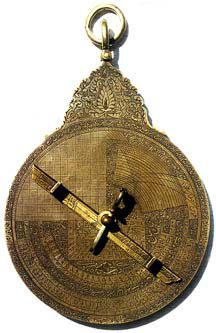Carnegie Observatories Persian Astrolabe / Biographies of Previous Owners
These biographies and photographs are lifted from the Sonoma University web site. If you want to see more details on any of the names below, just click of their names. This will take you out of my Astrolabe Site, however, so you will have to use your browser's back button to return.

Lady Margaret Lindsay Huggins, Astronomer (1848 - 1915)
Lady Huggins was truly a Renaissance women, being accomplished in music, painting, writing, an expert on antique furniture, and astronomy. Her interest in astronomy began early on when her grandfather taught her the constellations. She began to construct homemade instruments and finally arranged to meet William Huggins, a spectroscopist, through the telescope maker Howard Grubb of Dublin. She married Huggins in 1875 and they became close collaborators. Together they produced some of the earliest spectra of astronomical objects, most notably the Orion nebula.
photo source: Wellesley College Archives

Photo source: Mary Lea Shane Archives, Lick Observatory
William Huggins (7 February 1824 1904 12 May 1910)
Huggins was one of the wealthy British “amateurs” who contributed so much to 19th century science. At age 30 he sold the family business and built a private observatory five miles outside London. After G.R. Kirchhoff and R. Bunsen’s 1859 discovery that spectral emission and absorption lines could reveal the composition of the source, Huggins took chemicals and batteries into the observatory to compare laboratory spectra with those of stars. First visually and then photographically he explored the spectra of stars, nebulae, and comets. He was the first to show that some nebulae, including the great nebula in Orion, have pure emission spectra and thus must be truly gaseous, while others, such as that in Andromeda, yield spectra characteristic of stars. He was also the first to attempt to measure the radial velocity of a star. After 1875 his observations were made jointly with his talented wife, the former Margaret Lindsay Murray (above).
Photo source: Hale Observatories

